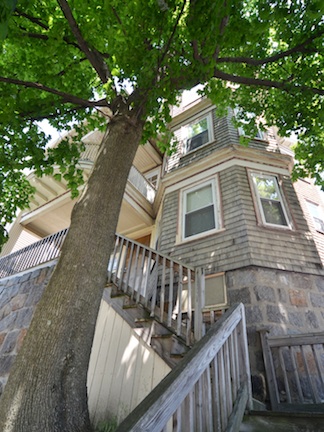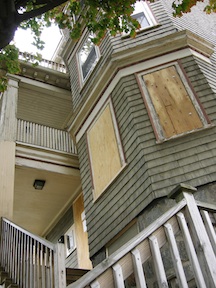May 31, 2012
 77 Draper Street in May 2012: Once boarded up and forlorn, the three decker has a new owner and a fresh look. Photo by Chris LovettIf anything proves the Dorchester real estate market is volatile, it’s the three-decker on Meetinghouse Hill, at 77 Draper Street.
77 Draper Street in May 2012: Once boarded up and forlorn, the three decker has a new owner and a fresh look. Photo by Chris LovettIf anything proves the Dorchester real estate market is volatile, it’s the three-decker on Meetinghouse Hill, at 77 Draper Street.
A developer bought units in the building when the market was slumping in the 1990s. He sold the entire house in 1999 for just under $200,000. Seven years later, after two refinancings—up to $405,600—and a three-alarm fire, the property was again on the way to foreclosure.
The next buyers got the house for $50,000 and turned it back into condominiums, selling units for a total on paper of almost $1 million. But those transactions led to three more foreclosures and a federal indictment against one of the development partners for mortgage fraud.
But by March of this year, the roller coaster had come full circle.
The same developer who bought distressed units and sold a recombined three-decker in 1999 did it again, this time with a sales price of $362,000. What had previously been a sinkhole for mortgage lenders, on a street dotted with multiple foreclosures on three-deckers, was now just another hot property in a market on the way up.
 77 Draper Street in 2007: The same three decker shown above, but in bleaker times. Photo by Chris LovettThe broker in the sale and the owner of the Dorchester firm Bayside Properties, Jessie Cuddy, said the house—hugged by a three-story maple tree, and only a short walk from Ronan Park—attracted three offers. And, if the market frenzy of the bubble years was still missing, there was appeal in the math, even for an investor buying with a higher down payment.
77 Draper Street in 2007: The same three decker shown above, but in bleaker times. Photo by Chris LovettThe broker in the sale and the owner of the Dorchester firm Bayside Properties, Jessie Cuddy, said the house—hugged by a three-story maple tree, and only a short walk from Ronan Park—attracted three offers. And, if the market frenzy of the bubble years was still missing, there was appeal in the math, even for an investor buying with a higher down payment.
“If you put $100,000 down, you’re going to be, on a monthly basis, making $1,000 or $1,500,” she calculated. “It’s not a bad return for your money.”
Though condos in multi-family houses still work better in some locations than others, buyers in the Dorchester housing market can take advantage of low interest rates on mortgages and rising rents.
According to the city’s Department of Neighborhood Development (DND), the median rent for units in Boston with one to three bedrooms increased last year by 25 percent, to $2,000 a month. In Dorchester, the increase was 6 percent, to $1,450 a month.
But, as of May 2012, the owner of the Dorchester real estate firm In Realty, Justin Green, says the increase in apartment rents in Dorchester has continued, going up 15 percent since 2010—a period when many potential buyers were still sidelined by a less attractive market, more stringent criteria for borrowing, or general economic insecurity.
Green calls this year’s spring sales market “crazy” and says it’s as busy as it was at the height of the last housing boom. With his firm’s listings on the market last year for an average of 30 to 90 days, he currently figures a turn-around time of 17 days. And, this year, he reports more than three-quarters of his listings have sold, with “multiple simultaneous offers.”
“I attribute that to low rates and the fact that rental prices have gone up so quickly,” he said.
By Green’s calculation, Dorchester average monthly rents have gone from slightly above $1,300 in 2005 to this year’s figure of more than $1,500.
One renter who moved to Dorchester is Gibran Rivera, a former resident of Jamaica Plain, where the city reports the median rent last year was $245 a month higher. Rivera says he likes Dorchester, explaining, “This is what Jamaica Plain used to be.”
There have been properties in Dorchester recently that have been sold above their listing price, including an attached single-family home a few blocks from Neponset Circle and a two-bedroom condo on St. Mark’s Road. And Green can point to one two-bedroom unit on Meetinghouse Hill renting at $1,850 a month—a condo in an eight-year-old building with a granite-countered chef’s kitchen and a Jacuzzi.
But, a few blocks away, on Hendry Street, progress toward market recovery over the last four years has required government money and intervention by the non-profit Dorchester Bay Economic Development Corp. (EDC).
The EDC’s executive director, Jeanne DuBois, says the non-profit acquired 20 distressed properties in Dorchester and has already found new owners for eleven. Aside from getting buildings renovated, the EDC has also worked on community organizing around Hendry Street, and DuBois says there’s still a need for work on more “problem properties.”
The city’s DND shows the heaviest concentration of foreclosed properties lies west of Dorchester Avenue. And the executive director of the Codman Square Housing Development Corp. (HDC), Gail Latimore, says non-profits hoping to salvage foreclosed properties need state funds to offset the recent decrease in federal money.
“We do not have the cash,” said Latimore. “We rely on public funding, which can be slow for putting money down on properties.” Most of the foreclosed properties acquired by the NDC, she said, have been turned over to owner-occupants.
Latimore describes the Dorchester market as still “fairly speculative.” And, if some investors who bought distressed properties have made improvements and filled vacancies, others have drawn attention from the city’s campaign against “problem properties.”
“We still have competition in the market with private investors who continue to scoop up properties,” said Latimore. According to a study for the NDC, properties in the Codman Square Four Corners area have received more investment from owner-occupants than from absentee owners.
Besides recovering distressed properties, the HDC and EDC have been developing new rental housing along the Fairmount Corridor. Still under construction is an affordable housing co-op with ground floor retail space in the old AB & W property on Washington Street, near a future stop on the Fairmount/Indigo line.
Helping to attract residents for the AB & W co-op through a lottery was the Greater Four Corners Action Coalition. By the lottery’s deadline in April, according to the coalition’s lead organizer, Pamela “Mela” Bush Deonarain, the co-op’s 24 units had attracted 1,300 applicants.
“If you have only 24 units of housing and 1,300 people apply for it,” she said, “that shows a tremendous need for affordable housing.”
The coalition and the HDC, along with the Boston Tenant Coalition, have also been trying to help area residents in the greatest danger of being displaced by either mortgage trouble or the rising cost of housing.
“What we don’t want to see is all that flipping going on. That’s how we got where we are today,” said Bush Deonarain. “The only person who’s happy when their value goes up,” she said, “is the one who’s going to sell their house. Otherwise, it’s just more taxes they have to pay on the inflated value of the property.”
During the last housing bubble, hundreds of condo conversions in Boston three-deckers led to a spike in values that was followed by a rash of foreclosures and short sales. In 2010 and 2011 alone, according to the DND, almost half the 399 foreclosures in Boston took place in condos, and another 84 took place in three-deckers. Since 2008, the city has played a role in the recovery of 388 bank-owned properties. And the DND estimates that, without its prevention efforts, Boston’s foreclosure rate would have been 38 percent higher.
The DND’s director, Evelyn Friedman, says that in a “modest income market,” three-decker units that sell as condos are still “very vulnerable.” But the DND recently began a campaign to encourage purchase and improvements of three-deckers as single properties. And, with three-decker median prices already climbing last year, an investor who bundled distressed condo units at $60,000 apiece would be in a position, even after improvements, to make a profit by selling a whole three-decker.
“It’s bringing back the old three-deckers,” said DuBois, “where the owner lived in one unit and mom and dad in the other.”
Though Dorchester condos on the market are currently listed for as high as $369,000 near Red Line stations or in areas with architectural showcases, some three-deckers have been listed for well over $400,000, including one a few blocks from Fields Corner that was renovated after being vacant.
Michael Stella, who has been redeveloping houses in Dorchester since the 1970s, says the backlog of troubled properties from the last downturn cleared up more quickly than he had expected. And he agrees that the once severely troubled multi-family market has been attracting more people who want to own as occupants or investors.
“For a while, it seemed like there were a lot of three-families that were sitting on the market for $350,000 to $400,000 and there didn’t seem to be a lot of demand for them,” he said. “But, now, they’re coming off the market more quickly.”
In the meantime, Stella says he’s keeping his rents on the low side, to minimize turnover and intervals of vacancy. He also says that despite any improvement in the housing market, there has been little gain in tenant incomes.
“They’re just squeezed in so many different directions, with food, fuel, with a car,” he said. “That hasn’t gotten any better.”


